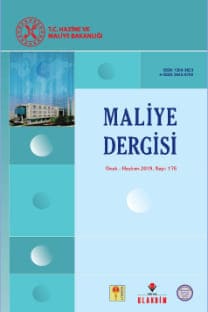Borsa İstanbul’da Mülkiyet ve Kontrol Yapıları
Ownership and Control Structures in Borsa Istanbul
___
- Almeida, H.V. ve Wolfenzon, D. (2006), “A Theory of Pyramidal Ownership and Family Business Groups”, The Journal of Finance, 61(6), 2637-2680.
- Atan, S., Bask ıcı, Ç. ve Ercil, Y. (2020). “Şirket Ağları Üzerinden Sahiplik İlişkilerine Yönelik Stratejilerin Belirlenmesi”, Doğuş Üniversitesi Dergisi, 21(2), 79-91.
- Bainbridge, S.M. (2007), “The Scope of the Sec's Authority over Shareholder Voting Rights”, UCLA School of Law Research Paper, (07-16).
- Bebchuk, L., Kraakman, R. ve Triantis, G. (2000), Stock Pyramids, Cross- Ownership, and Dual Class Equity, in Concentrated Corporate Ownership (R. Morck, ed.), Harvard Law School Olin Discussion Paper , No.249, 295-315.
- Bennedsen, M. ve Wolfenzon, D. (2000), “The Balance of Power in Closely Held Corporations”, Journal of Financial Economics, 58(1-2), 113-139.
- Black, B.S. ve Khanna, V.S. (2007), “Can Corporate Governance Reforms Increase Firm Market Values? Event Study Evidence from India”, Journal of Empirical Legal Studies, 4(4), 749-796.
- Black, B.S., Jang, H. ve Kim, W. (2006), “Does Corporate Governance Predict Firms' Market Values? Evidence from Korea”, The Journal of Law, Economics, and Organization, 22(2), 366-413.
- Claessens, S., Djankov, S. ve Lang, L.H. (2000), “The Separation of Ownership and Control in East Asian Corporations”, Journal of Financial Economics, 58(1-2), 81-112.
- Claessens, S., Djankov, S., Fan, J.P. ve Lang, L.H. (2002), “Disentangling the Incentive and Entrenchment Effects of Large Shareholdings”, The Journal of Finance, 57(6), 2741-2771.
- Claessens, S. ve Yurto ğlu, B. (2012), “Corporate Governance and Development: An Update”, Interna tional Finance Corporation, World Bank.
- Demirağ, I. ve Serter, M. (2003), “Ownership Patterns and Control in Turkish Listed Companies”, Corpor ate Governance: An International Review, 11(1), 40-51.
- Demsetz, H. (1986), “Corporate Control, Insider Trading, and Rates of Return”, The American Economic Review, 76(2), 313-316.
- Faccio, M. ve Lang, L.H. (2002), “The Ultimate Ownership of Western European Corporations”, Journal of Financial Economics, 65(3), 365-395.
- Goshen, Z. ve Hamdani, A. (2020), “Corporate Control, Dual Class, and the Limits of Judicial Review”, Columbia Law Review, 120(4), 941-994.
- Gurrea-Martínez, A. (2021), “Theory, Evidence, and Policy on Dual-Class Shares: A Country-Specific Response to a Global Debate”, European Business Organization Law Review, 22(3), 475-515.
- Holmen, M. ve Nivorozhkin, E. (2007), “The Impact of Family Ownership and Dual Class Shares on Takeover Risk”, Applied Financial Economics, 17(10), 785-804.
- Jensen, M.C. (1986), “Agency Costs of Free Cash Flow, Corporate Finance, and Takeovers”, The American Economic Review, 76(2), 323-329.
- La Porta, R., Lopez-de-Silanes, F. ve Shleifer, A. (1999), “Corporate Ownership Around the World”, Journal of Finance, 54, 471-518.
- La Porta, R., Lopez-de-Silanes, F., Shleifer, A. ve Vishny, R.W. (1997), “Legal Determinants of External Finance”, The Journal of Finance, 52(3), 1131-1150.
- La Porta, R., Lopez-de-Silanes, F., Shleifer, A. ve Vishny, R.W. (1998), “Law And Finance”, Journal of Political Economy, 106(6), 1113-1155.
- La Porta, R., Lopez-de-Silanes, F., Shleifer, A. ve Vishny, R.W. (2000), “Investor Protection and Corporate Governance”, Journal of Financial Economics, 58(1-2), 3-27.
- Lefort, F. (2005), “Ownership Structure and Corporate Governance in Latin America”, Revista Abante, 8(1), 55-84.
- Leung, M. ve Tung, R. (2018), Dual-Class Shares: The Good, The Bad, and The Ugly. CFA Instiute.
- Li, J., Ren, D., Feng, X. ve Zhang, Y. (2016), “Network of Listed Companies Based on Common Shareholders and the Prediction of Market Volatility”, Physica A: Statistical Mechanics and its Applications, 462, 508-521.
- Orbay, H. ve Yurtoğlu, B.B. (2006), “The Impact of Corporate Governance Structures on the Corporate Invest ment Performance in Turkey”, Corporate Governance: An International Review, 14(4), 349-363.
- Rotundo, G. ve D’Arcangelis, A.M. (2010), “Ownership and Control in Shareholding Networks”, Journal of Economic Interaction and Coordination, 5(2), 191-219.
- Shen, J. (2016), “The Anatomy of Dual Class Share Structures: A Comparative Perspective”, Hong Kong Law Journal, 46(2), 477-510.
- Shleifer, A. ve Vishny, R.W. (1986), “Large Shareholders and Corporate Control”, Journal of Political Economy, 94(3), 461-488.
- Silva, A.L.C. ve Leal, R.P.C. (2006), “Ownership, Control, Valuation and Performance of Brazilian Corpora tions”, Corporate Ownership & Control, 4(1), 300-308
- Yılgör, A.G. ve Yücel, E. (2012), “İşletmelerin Sahiplik Yapısının İncelenmesi: Sahiplik ve Kontrol Ayrımı Konusunda Ç ıkarımlar”, Uluslararası Yönetim İktisat ve İşletme Dergisi, 8(16), 41-57.
- Yurtoğlu, B.B. (2000), “Ownership, Control and Performance of Turkish Listed Firms”, Empirica, 27(2), 193-222.
- Yurtoğlu, B. (2003), “Corporate Governance and Implications for Minority Shareholders in Turkey”, Discussion Paper, No. 2003/7, Turkish Economic Association, Ankara.
- ISSN: 1300-3623
- Yayın Aralığı: Yılda 2 Sayı
- Başlangıç: 1973
- Yayıncı: Hazine ve Maliye Bakanlığı
Sinem ATICI USTALAR, Ayçıl YÜCER
Borsa İstanbul’da Mülkiyet ve Kontrol Yapıları
Türkiye’de Hisse Senedi Getirileri, Enflasyon ve Büyüme İlişkileri: Wavelet Uyum Analizi
Seda SÖNMEZ ÖZEKİCİOĞLU, Emrah NOYAN
Bölgesel Asgari Ücret Varsayımı Altında Bölgelerin Kümeleme Analizi Yöntemleriyle Tespiti
ABDÜLNAMİD ÖZGÜN BİRKALAN, Hakan BAY
İmar Rantı Vergisi Türü Olarak Değer Artış Payı: Güncel Veriler Işığında Tespit ve Öneriler
Dijitalleşme Sürecinde İstihdam Olgusunun Çok Boyutlu Analizi: Bibliyometrik ve İçerik Analizi
Ayten YAĞMUR, Şerife DURMAZ, Sergen GÜRSOY
Dijital Ekonominin Vergilendirilmesi: Seçilmiş Bazı Ülke Uygulamaları
